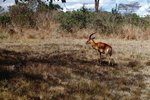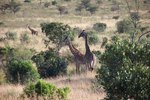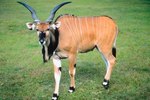
The sable antelope is easily recognizable by the massive horns atop his head, but those aren't his only distinct adaptations. In addition to physical adaptations noticeable from birth, he has adapted his behavior over time to ensure his survival. Despite the formidable predators and sometimes harsh weather conditions of his African habitat, he can survive longer than 17 years in the wild.
Self-Defense
While both sexes of sable antelope have horns, the male's can grow well over five feet in length, giving him two powerful weapons for defending himself and his herd. These curved and sharply-pointed horns make him an imposing-looking threat, and he isn't afraid to use them. The sable antelope is known for defending himself against any lion daring enough to attack him, and even the king of the jungle seldom is a match for his muscular body and massive horns -- most of the time, a lion won't even attempt to take him on.
Natural Camouflage
Though the adult sable antelope is a powerful fighter -- even a female grows horns nearly 40 inches in length -- a newborn calf is equipped not for self-defense, but for avoiding conflict altogether. The calf is born with a sandy-brown coat that is close in color to his environment, and well-suited for camouflage. For the first three weeks of his life, he stays hidden in the tall grass near his mother's herd. This prevents him from being seen by predators, like lions and hyenas, who prey selectively on the young because of their inability to defend themselves. As he matures, his coat changes color, taking on a distinctly darker hue.
Strength in Numbers
The sable antelope has adapted to live in a herd, where the males can protect females and they can procreate. To prevent potentially deadly competition with other males, he lives as the solitary bull in a herd of 15 to 25 females and their young. The herd lives, forages and travels together as a group, keeping predators at bay by functioning as a solitary unit. When young males mature around the age of three, they are evicted from the group and leave to start a new herd. If the bull is challenged for his herd by another, he will fight the challenger using his horns. He does not intentionally fight to the death, so fatalities from these fights are highly uncommon.
Dietary Adaptations
Large-leaf foliage and short grasses comprise the sable antelope's preferred diet. He typically only munches on grass shorter than six inches. His diet is adapted to his environment, though, so he supplements his herbivorous habits by finding nutrients outside of plants. For example, he may chew up bones, which contain minerals his body needs but cannot get from grasses and herbs. He also seeks out natural mineral licks on a regular basis to supplement his diet. Because his body needs water at least once every two days, he and his herd are never more than two miles from the nearest source.
References
Photo Credits
-
Jupiterimages/Photos.com/Getty Images
Writer Bio
Tom Ryan is a freelance writer, editor and English tutor. He graduated from the University of Pittsburgh with a degree in English writing, and has also worked as an arts and entertainment reporter with "The Pitt News" and a public relations and advertising copywriter with the Carnegie Library of Pittsburgh.




